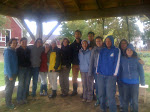Thursday, March 24
This morning our group cared for the animals' pastures. First we seeded some pastures with white clover mixed with an inoculant--a bacteria that helps the clover plant jump-start its nitrogen fixing job.
 |
| preparing to broadcast the seed |
 |
| Olivier waxing poetic on inoculant |
Here's how we did it. We drove to the pasture in North Wyslaski field. We shared out half a bag of white clover seed--grass seed is cheap at around $75 for 50 pounds and legume seeds are quite dear at $200 for 50 pounds--in our five buckets. Then we shared out the inoculant--200 million viable bacteria per gram--into our seed. After stirring, we added a bit of water and stirred some more to stick the inoculant to the seed. Then we marched into the pasture, lined up and began our "step, step, fling" pattern across the land. We covered another pasture--South Wyslaski. We then went to Hazel's fields that had been seeded yesterday. Here's where the real fun began:
We approached the field and saw the harrow on the grass with a section of chain-link fence tied behind it. On the fence portion of the modified harrow, there were four tires. It looked like this:
 |
| Ah-ha. We sit on them |
 |
Hmmm... what are those tires for?
|
In the afternoon, our group took on manure--demolishing an old manure spreader and using the tractor to move manure and and rocks. This old manure spreader has seen better days and the axle is still good, so the demolition team of Nora, Sophia, Emily and Rebekah moved in.
 |
| Josh coaching Nora and Sophia on angle-grinder |
 |
| Emily with sledge hammer |
 |
| Emily and Rebekah unbolting |
 |
| Sophia with angle grinder |
 |
| Moving rock/gravel |
I had some time on the tractor. First, I helped to move horse manure out of the paddock. It was tricky because some parts of the pile were frozen and other parts were mushy. Moving the tractor in was kind of nerve-racking because it would tip and roll a bit. And a few times, I scooped up the soil below the pile and that is hazardous to leave trenches in a horse paddock. "Need more practice," I told myself.
Then I was tasked with moving a pile of rock/gravel to a wet place in the barn yard. Here's the sequence: Approach the pile to be moved Before you get there, level the bucket and lower it to the ground. Approach the pile again and slightly tip the bucket down. Moving forward, allow the bucket to begin loading. As the bucket fills, slowly tip back and lift (but not TOO high). Back up out of the pile and deliver the load to designated spot. " Lather, rinse, repeat" until pile is gone.

















































